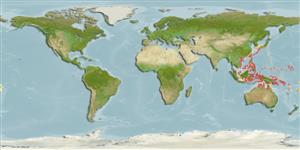>
Gobiiformes (Gobies) >
Gobiidae (Gobies) > Gobiinae
Etymology: Trimma: Greek, trimma, -atos = something crushed (Ref. 45335); hayashii: Named for Mr. Masayoshi Hayashi..
More on authors: Hagiwara & Winterbottom.
Environment: milieu / climate zone / depth range / distribution range
Ecología
marino asociado a arrecife; rango de profundidad 0 - 26 m (Ref. 58123). Subtropical
Western Pacific: Japan to the Solomons.
Tamaño / Peso / Age
Maturity: Lm ? range ? - ? cm
Max length : 2.3 cm SL macho / no sexado; (Ref. 58123)
Short description
Morfología | Morfometría
Espinas dorsales (total): 7; Radios blandos dorsales (total): 8-9; Espinas anales 1; Radios blandos anales: 7 - 8. This species is characterized by the following: dorsal spine a little elongated or not; presence of a basal membrane between the pelvic fins; absence of predorsal scales; an interorbital but no postorbital trench; absence of cheek and opercular scales; fifth pelvic fin ray branched sequentially once or twice and, uniquely among known species of Trimma, has a bilateral, pupil-sized black spot on the branchiostegal membrane; live individuals with red spots, a little smaller than the pupil diameter on the head and nape, the posterior half of body has 3 yellow stripes separated by 2 grey stripes, and the black spots on the branchiostegal membranes are ocellated with white or blue (Ref. 58123).
Lives under corals in embayments, which are sometimes covered by siltation. Also found in caves and crevices of sheltered reefs (Ref. 90102). It often positions itself upside-down on the roof of the recess (Ref. 58123).
Life cycle and mating behavior
Madurez | Reproducción | Puesta | Huevos | Fecundidad | Larva
Hagiwara, K. and R. Winterbottom, 2007. Two new species of Trimma (Gobiidae) from the Western Pacific. Bull. Natl. Mus. Nat. Sci., Ser. A, Suppl. 1:163-174. (Ref. 58123)
IUCN Red List Status (Ref. 130435)
Threat to humans
Harmless
Human uses
Más información
Nombres comunesSinónimosMetabolismoDespredadoresEcotoxicologíaReproducciónMadurezPuestaAgregación para la puestaFecundidadHuevosEgg development
Age/SizeCrecimientoLength-weightLength-lengthLength-frequenciesMorfometríaMorfologíaLarvaDinámica larvariaReclutamientoAbundanciaBRUVS
ReferenciasAcuiculturaPerfil de acuiculturaRazasGenéticaElectrophoresesheritabilidadEnfermedadesProcesamientoNutrientsMass conversion
ColaboradoresImágenesStamps, Coins Misc.SonidosCiguateraVelocidadTipo de nataciónSuperficie branquialOtolitosCerebrosVisión
Herramientas
Special reports
Download XML
Fuentes de Internet
Estimates based on models
Preferred temperature (Ref.
123201): 25.3 - 29.3, mean 28.7 °C (based on 1246 cells).
Phylogenetic diversity index (Ref.
82804): PD
50 = 0.5000 [Uniqueness, from 0.5 = low to 2.0 = high].
Bayesian length-weight: a=0.01023 (0.00477 - 0.02194), b=3.02 (2.84 - 3.20), in cm total length, based on LWR estimates for this (Sub)family-body shape (Ref.
93245).
Resiliencia (Ref.
120179): Alto, población duplicada en un tiempo mínimo inferior a 15 meses (Preliminary K or Fecundity.).
Fishing Vulnerability (Ref.
59153): Low vulnerability (10 of 100).
Nutrients (Ref.
124155): Calcium = 258 [88, 845] mg/100g; Iron = 1.74 [0.70, 4.09] mg/100g; Protein = 18.7 [16.5, 20.7] %; Omega3 = 0.254 [0.080, 0.784] g/100g; Selenium = 14.2 [3.9, 42.1] μg/100g; VitaminA = 77.4 [13.4, 432.1] μg/100g; Zinc = 3.07 [1.55, 5.49] mg/100g (wet weight);
